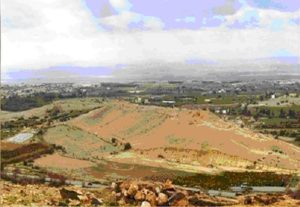 1
1

Great pyramid in Cholla
 17. 04. 2024
17. 04. 2024



 1
1

 17. 04. 2024
17. 04. 2024
 6
6

 16. 04. 2024
16. 04. 2024
 8
8

 15. 04. 2024
15. 04. 2024
 1
1

 6
6
 27. 12. 2018
27. 12. 2018

According to archaeologists who found evidence of a cosmic explosion, a meteor or comet exploded in the Middle East about 3700 years ago. There is a theory that this eruption wiped out humanity in an area called Middle Ghor, north of the Dead Sea.
Scientists at the annual meeting of American Schools of Oriental Research (14 - 17.11.2018) described the situation as follows:
"The blast immediately destroyed everything within 500 square kilometers. He swept not only the cities but also the fertile soil, and during the shock wave he covered Middle Ghor with hot brine from an anhydride mixture of salts and sulfates from the Dead Sea. On the basis of archaeological evidence, it took at least 600 years for the damage and soil pollution to recover sufficiently and for the civilization of eastern Middle Ghor to be restored. "
One of the ruined places was Tall el-Hammam, an ancient city that spanned 36 hectares.
Among the evidence scientists have uncovered is the 3700 year-old pottery from Tall el-Hammam of unusual appearance. The ceramic surface was vitrified (turned into glass). The temperature was so high that parts of the zirconium in the pottery turned into gas - that requires a temperature of more than 4000 degrees Celsius, said Phillip Silvia, field archaeologist and site manager of Tall el-Hammam. The strong heat did not last long enough to burn the entire pottery, parts of the ceramic below the surface were relatively undamaged.

Tell El-Hammam in Jordan - New research suggests that the city and the surrounding area destroyed an overhead explosion before 3700 (© Phillip Silvia)
According to Silvia, the only natural event that can cause such unusual damage is the above-ground explosion of a space body - something that has happened occasionally throughout Earth's history, such as the 1908 explosion at Tunguska in Siberia. Archaeological excavations and surveys in other cities in the affected area also indicate the sudden destruction of life about 3700 years ago, Silvia confirmed. No craters have been found yet. It is not clear whether the culprit was a meteor or a comet that exploded above the ground.
The fact that only 500 square kilometers of land was destroyed suggests that the explosion occurred at low altitudes, probably no more than 3 kilometers above the ground, Silvia said. By comparison, the Tunguska blast severely damaged 2150 square kilometers of land. The results are preliminary and research is ongoing, Silvia emphasized. The team includes scientists from Trinity Southwest, Northern Arizona University, DePaul University, Elizabeth City State University, New Mexico Tech and the Comet research group.